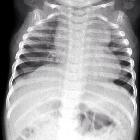partielle Lungenvenenfehlmündung





































Partial anomalous pulmonary venous return (PAPVR), also known as partial anomalous pulmonary venous connection (PAPVC), is a rare congenital cardiovascular condition in which some of the pulmonary veins, but not all, drain into the systemic circulation rather than in the left atrium.
Clinical presentation
Patients with large shunts may present with symptoms of dyspnea, chest pain and palpitations, signs like tachycardia and murmur can be encountered. Cases of secondary pulmonary arterial hypertension have been reported .
Pathology
Classification
Four types of PAPVR have been described:
- supra-cardiac
- persistent left superior vena cava
- right superior vena cava (most common)
- brachiocephalic veins (=innominate veins)
- cardiac
- right atrium
- coronary sinus
- infracardiac
- portal vein
- hepatic veins
- inferior vena cava (Scimitar syndrome)
- mixed
- a combination of two or more of the above anomalies
Left-sided PAPVR has been reported to be found more often in adults, whereas right-sided PAPVR is reported more commonly in children . It is unclear if this is because of a higher proportion of symptomatic manifestation of the latter. The left upper lobe vein anomaly is thought to be most common.
Associations
- in ~40% of patients with right-sided PAPVC, an atrial septal defect is seen
- more rarely it is seen with ostium primum defect, a subtype of atrioventricular defects
Radiographic features
Plain radiograph
Chest radiographic features are particular to each subtype of PAPVR. The abnormal vein is rarely identified, except in cases of Scimitar syndrome. Pulmonary venous congestion can be seen if the venous drainage is obstructed.
Cardiomegaly can also be seen if significant abnormal intracardiac venous drainage occurs.
CT
Utilization of contrast-enhanced studies with MDCT technology enables both detection and characterization of the anomalies. It is considered the imaging modality of choice .
Treatment and prognosis
Therapeutic options include surgical repair with ASD patching, intracardiac baffle, anomalous vein anastomosis, systemic vein translocation and Warden procedure inter alia.
Differential diagnosis
Imaging differential considerations include:
Siehe auch:
- Lungensequester
- Lungenvenenfehlmündung
- Atriumseptumdefekt
- Scimitar-Syndrom
- Lungenhypoplasie
- Situs ambiguus
- Snowman heart
- totale Lungenvenenfehlmündung
- pulmonary venolobar syndrome
- Zyanotischer Herzfehler
- meandernde Pulmonalvenen
und weiter:

 Assoziationen und Differentialdiagnosen zu partielle Lungenvenenfehlmündung:
Assoziationen und Differentialdiagnosen zu partielle Lungenvenenfehlmündung:






